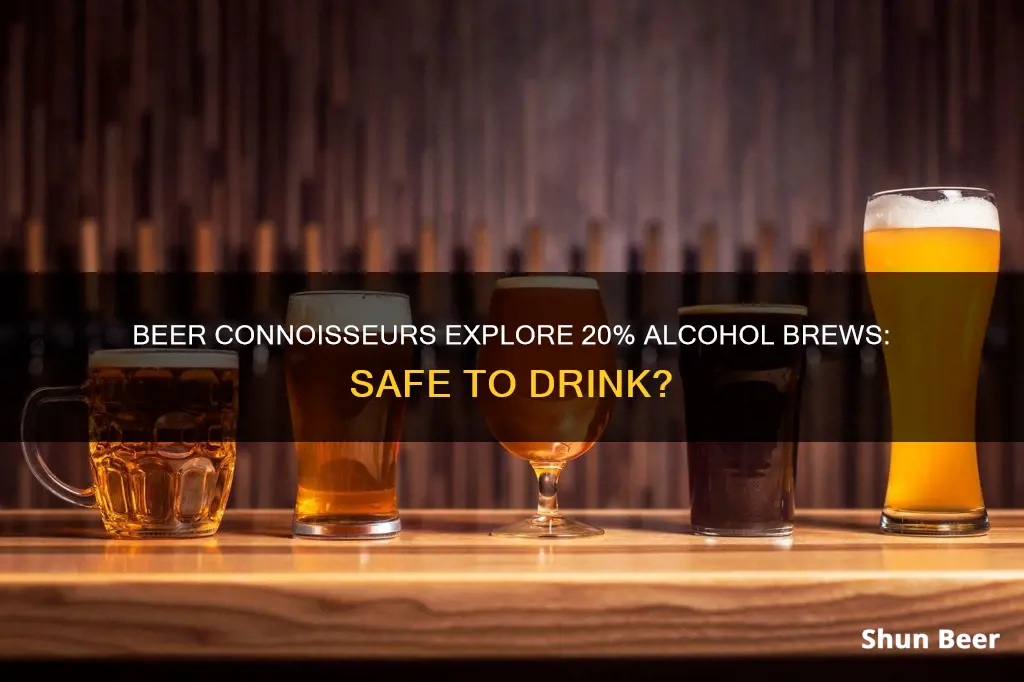
Alcohol has been a part of human civilization for at least 10,000 years, and while there are many kinds of alcoholic drinks, they are typically standardized to beer, wine, and liquor in the United States. Beer is the most popular alcoholic beverage worldwide, and a standard beer has between 4% and 6% ABV, although some beers have higher concentrations of alcohol. For instance, extreme beers such as Dogfish Head's 120 Minute IPA have 21% ABV. So, can you drink a 20% alcohol beer? Yes, but it's important to understand the effects of alcohol and consume it responsibly.
| Characteristics | Values |
|---|---|
| Beer with 20% alcohol | Possible, but not common |
| Typical alcohol content of beer | 4% to 6% ABV |
| Light beers | 2% to 4% ABV |
| Malt liquors | 6% to 8% ABV |
| Fortified wine | 16% to 24% ABV |
| Unfortified wine | 14% to 16% ABV |
| Standard drink | 12 ounces of beer |
| 4 ounces of wine | |
| 1-1/4 ounces of 80 proof distilled spirits |
What You'll Learn

A 20% ABV beer is possible to make at home
Brewing a 20% ABV beer at home is possible, but it requires careful planning and execution. Here are the steps you can follow to achieve this:
Ingredients and Equipment:
- Yeast: Choose a yeast strain with high alcohol tolerance, such as White Labs WLP099 (Super High Gravity Ale).
- Malt: Select an appropriate malt for the style of beer you want to brew. For example, German Pils and Munich malts for a Doppelbock, or British pale ale malt for an English barleywine.
- Adjuncts: Consider using adjuncts like corn sugar, honey, or maple syrup to increase the alcohol content. However, be cautious as too much sugar can affect the taste and put pressure on the yeast.
- Hops: Choose hop varieties that complement your malt selection and desired beer style.
- Equipment: Ensure you have the necessary equipment, including a large enough mash tun, kettle(s), carboy, and fermentation vessel.
Mashing and Sparging:
- Mash a large amount of malt (e.g., 31 lbs. or 14 kg) with enough mash liquor to achieve the desired mash thickness. For a 20% ABV beer, you may need to mash overnight to ensure complete conversion.
- Sparge slowly until all the sugar is extracted. Collect enough wort (e.g., 18 gallons or 68 L) for boiling.
Boiling and Hopping:
- Boil the wort in separate pots to reduce volume and minimize color pickup. Use a clip-on fan to prevent boil-overs and speed up evaporation.
- Add hops during the final stages of boiling. The specific amount and variety of hops will depend on your recipe and desired bitterness level.
Fermentation and Yeast Management:
- Prepare a yeast starter with the appropriate volume and specific gravity. Ferment the starter in a carboy.
- Oxygenate the wort and pitch the yeast. Consider using a yeast strain with high alcohol tolerance, such as White Labs WLP099.
- Ferment the beer until the activity subsides. Add fresh wort and oxygenate periodically to maintain a less stressful environment for the yeast.
- Use yeast nutrients and consider adding a second round of yeast to help the yeast handle the high alcohol content.
Aging and Carbonation:
- After fermentation, age the beer for a month or longer to allow the flavors to blend and mature.
- Bottle conditioning may not be suitable for such a high-ABV beer, so consider kegging and force carbonating.
Recipe Adjustments:
- Monitor the fermentation process and be prepared to make adjustments. You may need to add more yeast, change the temperature, or adjust the recipe to achieve the desired ABV and flavor profile.
- When brewing another batch, consider adding Beano earlier in the process to shorten fermentation time and convert more non-fermentables.
Brewing a 20% ABV beer at home is a challenging but rewarding endeavor. Remember to keep your yeast healthy and happy throughout the process, as it plays a crucial role in achieving the high alcohol content.
Beer Festivals: A Guide to the Frothy Fun
You may want to see also

A standard beer has 4-8% ABV
A standard beer typically has an alcohol by volume (ABV) percentage of between 4% and 8%. This can be compared to non-alcoholic beer, which contains less than 0.5% ABV, and to super high gravity beers, which can contain over 20% ABV.
In the United States, a "standard drink" is defined as any beverage containing 0.6 fluid ounces or 14 grams of pure alcohol. This is roughly equivalent to 12 fluid ounces of beer, four fluid ounces of wine, or 1.25 fluid ounces of 80-proof distilled spirits. However, it's important to note that these amounts are dependent on the percentage of alcohol by volume, and many beers, wines, and spirits do not follow this standard.
When it comes to drinking alcohol, it's important to monitor your consumption. Health experts recommend no more than four standard drinks per day and no more than ten standard drinks per week. Each additional drink can increase the risk of injury, accidents, and long-term health issues. To keep track of your consumption, you can read labels, use online calculators, or ask bar or restaurant staff.
Additionally, it's worth noting that the legal drinking age varies across the world. For example, in the United States, the legal drinking age is 21, while in other countries, such as those in Europe, the legal drinking age is typically lower.
Beer Butt Chicken: Does It Work?
You may want to see also

A 20% ABV beer is a distilled drink
A 20% ABV beer is not a distilled drink. Distilled drinks, or liquors, typically have an ABV of 20% and above.
Beer is typically the alcoholic beverage with some of the lowest alcohol levels. Usually, beers have an ABV between 3.5% and 7%, but there are outliers with higher or lower ABVs. Some beers may have an ABV of less than 1%, while some IPAs might have an ABV well above 10%.
The highest ABV beer mentioned in my sources is Samuel Adams Utopia, which has an ABV of 25%. This is an extreme example, and most beers with an ABV of 20% or higher are referred to as super high gravity beers.
Liquor, on the other hand, has some of the highest ABV levels of alcoholic beverages, with most liquors falling somewhere between 40% and 50% ABV. Vodka, for example, can have an ABV as high as 95%.
Distillation is the process of separating components of a mixture by boiling and then condensing the vapour. This process is often used to increase the alcohol content of a drink, as ethanol has a lower boiling point than water. However, it is not necessary to distill a drink in order to reach an ABV of 20%.
The process of ethanol fermentation will slow down and eventually stop as the alcohol produced becomes too concentrated for the yeast to tolerate. The typical tolerance for beer yeasts is between 8% and 12% ABV, while wine yeasts typically range from 14% to 18% ABV, with specialty yeasts reaching 20% ABV.
Therefore, a 20% ABV beer is not distilled, but it is at the upper limit of what can be achieved through fermentation alone.
Millenials' Work Culture: Beer on the Job?
You may want to see also

A 20% ABV beer is stronger than wine
It is possible to drink a 20% ABV beer, but it is not recommended to consume too much of it due to its high alcohol content. In fact, a 20% ABV beer is stronger than wine, which typically has a lower alcohol content.
The alcohol content of beer can vary, but it usually falls between 4% and 8% ABV. Some craft beers can have higher ABVs, reaching up to 12% or more. However, a 20% ABV beer is considered a super high gravity beer, and it is significantly stronger than your average beer.
On the other hand, wine typically has a higher alcohol content than beer. Most wine alcohol by volume falls between 12% and 14% ABV. Some wines, such as dessert wines and fortified wines, can have even higher ABVs, ranging from 15% to 24%. Despite this, a 20% ABV beer still surpasses the typical alcohol content of wine.
The difference in alcohol content between beer and wine can be attributed to their fermentation processes. Beer is typically fermented for a shorter time than wine, resulting in lower alcohol content. Additionally, the type of yeast and the country of origin can also impact the final alcohol content.
While a 20% ABV beer is stronger than your average glass of wine, it is important to note that liquor or spirits have even higher alcohol content. Liquor typically starts at around 20% ABV and can go as high as 95% ABV in some cases.
Consuming alcoholic beverages with high ABV can lead to intoxication and negative health effects. It is important to drink responsibly and in moderation to avoid potential risks associated with excessive alcohol consumption.
Beer Science: Brewing Chemistry and History Podcast
You may want to see also

A 20% ABV beer is stronger than liquor
A 20% ABV beer is stronger than most liquors. While liquor typically has an ABV range of 20% to 60%, beer usually has a much lower alcohol content, with an average ABV of 5%.
Liquor, also known as spirits or distilled spirits, is created by distilling a fermented grain or fruit product. This process increases the alcohol content, resulting in a higher ABV compared to beer. The average ABV for liquor is 40%, which is significantly higher than the average ABV for beer.
However, it is possible to brew beer with a much higher ABV. For example, Dogfish Head's 120 Minute IPA has an ABV of 21%, and Samuel Adams Utopia boasts an ABV of 25%. These extreme beers are brewed with large amounts of sugar or syrup to increase the alcohol level.
When comparing the strength of alcoholic beverages, it is important to consider the ABV, as it indicates the level of alcohol content in each drink. A higher ABV means a more potent drink, leading to faster intoxication. Additionally, drinks with higher ABV tend to have a stronger and more bitter taste.
While a 20% ABV beer may be stronger than most liquors, it is essential to remember that the effects of alcohol can vary depending on factors such as gender, age, weight, metabolism, and drinking frequency. However, assuming all other factors are equal, a 20% ABV beer will likely have a more pronounced effect compared to a typical liquor with a 40% ABV.
Chilling Beer Fast: How Do Chiller Sticks Work?
You may want to see also
Frequently asked questions
Yes, 20% ABV is very high for beer. The typical tolerance for beer yeasts is between 8% and 12% ABV. Most beers have an alcohol content of between 4% and 8%, with 5% to 6% being the standard in the US. Some craft beers can be as high as 12%.
Drinking any amount of alcohol comes with health risks. A 20% ABV beer is very strong and could lead to drunkenness and alcohol poisoning more quickly and in smaller doses than lower-ABV drinks.
Signs of alcohol poisoning include severe intoxication, the need for assistance walking, mental confusion, nausea, and vomiting. If you suspect alcohol poisoning, seek immediate medical attention.
The liver metabolises alcohol at a rate of approximately one drink per hour. Time is the only thing that will remove alcohol from the body.
The National Institute on Alcohol Abuse and Alcoholism (NIAAA) recommends that adults drink no more than seven drinks per week. Excessive drinking can lead to alcohol poisoning, hospitalisation, car accidents, and other injuries.







